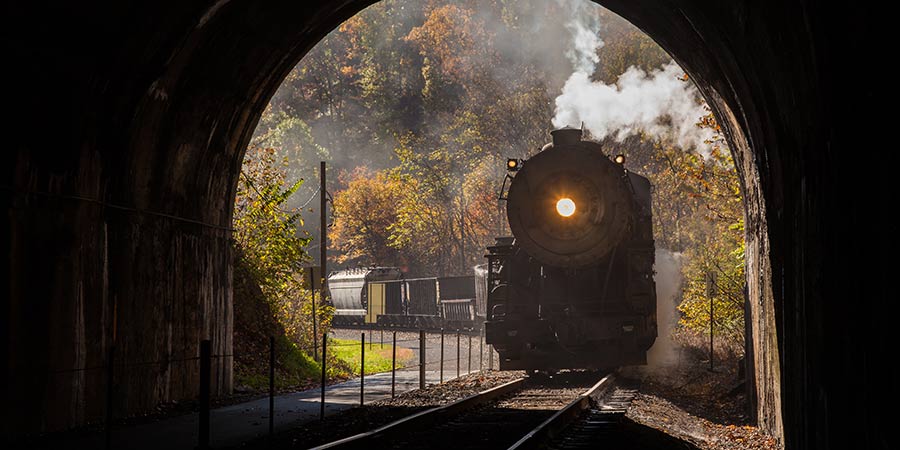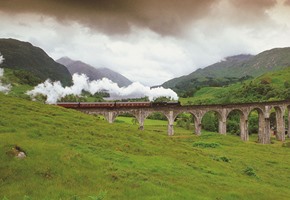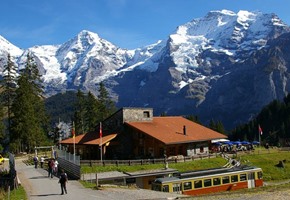As one of the most popular forms of travel in the world, railways have earned their place in the pantheon of human transport. From horsepower right through to high-speed locomotives, the history of our rail systems has featured some of the most ingenious moments in engineering, as pioneers came up with different ways to perfect train travel, some of which became the most important moments in railway innovation:
The first railway
To begin our story, we're going right back to the Corinthians in Ancient Greece, to around 600 BC when the first predecessor of the railway system was built. This 'railway' or rather 'rutway' was a series of grooves dug into the ground which guided various carts on a track of around four miles, over a paved trackway. This was called the Diolkos, and it was designed to carry boats through the Isthmus of Corinth, a narrow land bridge, as an alternative to sailing the much longer route around the Peloponnese peninsula.
Funiculars, mines and metal
The next step in the evolution of rail travel took place nearly 2,100 years later in Europe during the 16th century. It was then that the first ever known funicular was built in Salzburg, Austria and for all the history buffs out there, you'll be happy to hear that it's still in operation today. Known as the Reisszug, it was used to cart passengers and goods up to Hohensalzburg Castle. Shortly after this technological breakthrough, there came the invention and popular usage of wagon ways. Operating on a similar system as the Diolkos, these wily creations were pulled by horses on sets of wooden rails, carrying mining apparatus and materials between mineshafts across Europe during the 1550s and onward.
The 1760s saw a major addition to the railroads in the shape of the metal rail. A seemingly simple inclusion, these metal rails were revolutionary and came thanks to higher iron production, meaning wooden rails across the world now had the opportunity for a radical upgrade. This in turn were replaced with steel as the quality of the material improved over the years.
The Power of Steam
Arguably the biggest and most dramatic change in railways and in fact, modern industry itself, was the mighty and multi-purposed application of steam. While steam power had been in use for decades before the work of engineer James Watt, it had only been utilised for water pumps principally and not much else. Watt changed all that, and changed transportation history forever with the invention of a reciprocating engine which, when combined with his research on the use of high-pressure steam on pistons, saw the birth of the first ever steam locomotive in 1784. This was one of the most important innovations in the history of mankind, and the first fully operational steam railway was opened in1804 near Merthyr Tydfil in Wales by an engineer called Richard Trevithick.
People on the move
While all the aforementioned railways came a long way, none were specifically used for human transport apart from the Reisszug.
All of this changed in 1807 when the Mumbles and Swansea Railway (Wales again!) was adapted to become solely passenger based, consequently going down in the history books as the first ever passenger rail service. Originally built as a quarry railway for limestone and operating between Swansea and Mumbles, construction began on this horse-powered railway in 1805. This previously novel idea then swept across Britain, eventually leading to the development of first steam power, then electric. The Mumbles railway closed in 1959, but its influence on railway history is undeniable.
Electricity and evolution
What followed in the years after, was a freight load of iconic trains which shaped the railways as we know then today in various ways. George Stephenson, a true pioneer, came to the fore, perfecting a number of the designs, processes and inventions of those who came before him. His creations included such trains as the blücher, the first successful flanged-wheel adhesion locomotive, and the locomotion, the first steam powered passenger train. He also came up with the idea for the first ever railway carriage which he ominously called the 'experiment'.
Electric railways came next in 1837, with the first built in Scotland by a chemist called Robert Davidson in Aberdeen. His design ran on batteries which he later worked into a larger locomotive called the 'galvani'. After the galvani was destroyed by disgruntled railway workers, a similar train was built in Germany by Werner von Siemens, whose lichterfelde tram was the first of its kind ever built, and was supplied by running rails and an overhead line which reached forces of up to 180 volts of direct current.
The age of diesel and the high-speed train
Diesel powered railways took rail travel to a whole new level, offering a more productive fuel to use than that of the coal and electricity of years gone. The first diesel railway was created in Switzerland in 1906 as part of a collaborative effort between Rudolf Diesel, Adolf Klose and Gebrüder Sulzer. Despite not achieving immediate commercial success, the idea of diesel-powered railways took off almost straight away after Hermann Lemp, an electrical engineer perfected a control system which simplified the driving of diesel trains down to a single lever.
The most recent advancement after diesel was the introduction of the high-speed train. These trains come straight from the future, reaching astonishing high speeds as they zip across the landscape, reaching highs up to 267 miles per hour. The first of these was the magnificent Shinkansen, built between Tokyo and Osaka and since then, similar high-speed networks have been built across the world including in Great Britain, China and France.
With news of trains that will one day run underwater, trains powered by hydrogen and trains that can drive themselves, the future of rail travel looks bright, and we for one can't wait to see what's going to happen next.






